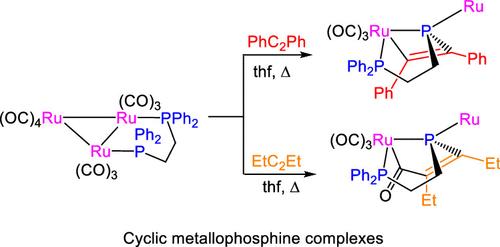通过一系列意想不到的金属介导的P-C和C-C键重排的环状金属膦
IF 4.7
2区 化学
Q1 CHEMISTRY, INORGANIC & NUCLEAR
引用次数: 0
摘要
[Ru3(CO)10(μ-dppe)] (dppe = 1,2-二(二苯基膦)乙烷)和内炔(RC≡CR, R = Ph, Et)的热反应产生52个电子的三核团簇,最好被认为是由一个配位于二钌中心的18个电子环金属膦配体组成的。它们是由一系列意想不到的、前所未有的金属介导的配体转化产生的,包括二膦一端的双P-Ph切割,以及炔烃捕获所产生的每一个膦啶和苯配体。本文章由计算机程序翻译,如有差异,请以英文原文为准。

Cyclic Metallophosphines via an Unexpected Series of Metal-Mediated P–C and C–C Bond Rearrangements
Thermal reactions of [Ru3(CO)10(μ-dppe)] (dppe = 1,2-bis(diphenylphosphino)ethane) and internal alkynes (RC≡CR, R = Ph, Et) afford 52-electron trinuclear clusters which are best considered as comprising an 18-electron cyclic metallophosphine ligand coordinated to a diruthenium center. They result from an unexpected and unprecedented series of metal-mediated ligand transformations, including the double P–Ph cleavage of one end of the diphosphine and capture of each of the resulting phosphinidine and benzyne ligands by the alkyne.
求助全文
通过发布文献求助,成功后即可免费获取论文全文。
去求助
来源期刊

Inorganic Chemistry
化学-无机化学与核化学
CiteScore
7.60
自引率
13.00%
发文量
1960
审稿时长
1.9 months
期刊介绍:
Inorganic Chemistry publishes fundamental studies in all phases of inorganic chemistry. Coverage includes experimental and theoretical reports on quantitative studies of structure and thermodynamics, kinetics, mechanisms of inorganic reactions, bioinorganic chemistry, and relevant aspects of organometallic chemistry, solid-state phenomena, and chemical bonding theory. Emphasis is placed on the synthesis, structure, thermodynamics, reactivity, spectroscopy, and bonding properties of significant new and known compounds.
 求助内容:
求助内容: 应助结果提醒方式:
应助结果提醒方式:


